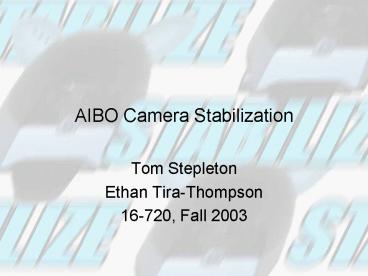AIBO Camera Stabilization - PowerPoint PPT Presentation
Title:
AIBO Camera Stabilization
Description:
We ignore this, too computationally intensive, introduces lag in images ... [a/e b/e] is not constrained by constrained least squares to be of length 1. ... – PowerPoint PPT presentation
Number of Views:42
Avg rating:3.0/5.0
Title: AIBO Camera Stabilization
1
AIBO Camera Stabilization
- Tom Stepleton
- Ethan Tira-Thompson
- 16-720, Fall 2003
2
AIBO vision is bumpy
- Legged locomotion induces vibration.
- Head (camera mount) is a great big cantilevered
mass.
3
Camera problems the lineup
- Obvious problems due to exposure time/cheap
optics
Lens distortion
Smear
4
Camera problems the lineup
- Subtle problems due to sample rate
Skew/bending
Stretching
5
Camera problems the lineup
- Subtle problems due to sample rate
Skew/bending
Stretching
6
Goal Take AIBO from this
7
to this
Smooooooooth
8
Stabilization Basics
- Compute homographies between successive images in
your sequence. - Transform sequence images one by one to make a
continuous, smooth stream. - Problems error accumulates, especially with more
degrees of freedom (e.g. affine transformations). - Many papers are about dealing with this.
9
Mosaicing Video SequencesNetzer, Gotsman
- Suggests using a sliding window of multiple
images to compute more accurate registration of
each frame - We ignore this, too computationally intensive,
introduces lag in images - Treat each new image as one of translation,
rigid, similarity, affine, or projective
transformation. Try each, pick the one with the
lowest error, with some bonus to simpler
transformations. - Instead of trying all 5 on each frame at run
time, we did some trials and found rigid
transformations satisfactory.
10
Camera Stabilization Based on 2.5D Motion
Estimation and Inertial Motion FilteringZhu, Xu,
Yang, Jin
- Typically, camera movements fall into a few
classes of motion. (e.g. panning, dolly,
tracking,) We can pass through movement on the
dominant dimension and stabilize on the
non-dominant dimension. - Since our motions are typically constrained to
the horizontal plane, we can compensate for
vertical bouncing and rotation, but leave
horizontal motion unchecked.
11
Our approach
- AIBO vibration is very regular.
- Rotation oscillates around 0.
- Vertical bouncing oscillates around a fixed
value. - Horizontal bouncing oscillates around a value
determined by AIBOs turning and sidestepping
velocities (which we know!).
So
12
Its a control problem now!
- Over many frames, image motion should tend toward
fixed (or predictable) values. - Use an image placement controller that allows
high-frequency changes in placement, but enforces
this constraint. - Specifically, we extract and adjust the x,y
coordinates and ? rotation used for image
registration.
13
The obligatory flowchart
Correct H for drift
Transform and show Image N
H H H (for N?1)
Compute H for N?N-1
Precomputed H for N-1?1
Image N-1
Image N
ltlt Past
Future gtgt
14
How to find corresponding points
- Q How do you find corresponding points in Image
N and Image N-1? - A Andrew and Ranjiths RANSAC from Assignment 5.
- Q Oh.
- A Its pretty robust, even to blurry, smeared
images.
15
Why find H indirectly?
- We could simply find the H from Image N to the
corrected, transformed Image N-1, right? - Wrong-o! The corrected image is jagged, noisy.
RANSAC would freak. - Instead, first find H from Image N to the normal
Image N-1. - Then premultiply it with the accumulated H (H)
from the normal Image N-1 to Image 1.
16
How do we get x, y, and ??
- Its easy if our homography is just a rigid
transform. - Its easy to adjust them, too.
- A cop out? Perhaps it doesnt fix all the
aberrations in the AIBO image. Its a start,
though.
17
Finding rigid transformations (1 of 2)
- Step 1 Constrained least squares.
P Image N point u,v N1 point
The U matrix
18
Finding rigid transformations (2 of 2)
- Step 2 Throw away image scaling.
- Divide a, b, c, d, and e by e, then by the length
of a b. - Otherwise the image will shrink as you walk
forward.
a/e b/e is not constrained by constrained
least squares to be of length 1.
19
Fighting drift, step by step
- Isolate ? from H
- Apply really simple correction premultiply H by
a rotation matrix that rotates by -?/constant
(forcing it back toward 0). - Isolate tx and ty from H
- Apply similar correction. We should force ty
toward a predicted value based on turning and
sidestepping. We dont right now, forcing it to 0
instead.
20
Demo time!
- Hallway scene
- Normal, stabilized, and side-by-side
- Lab scene
- Normal, stabilized, and side-by-side
21
Any questions?































